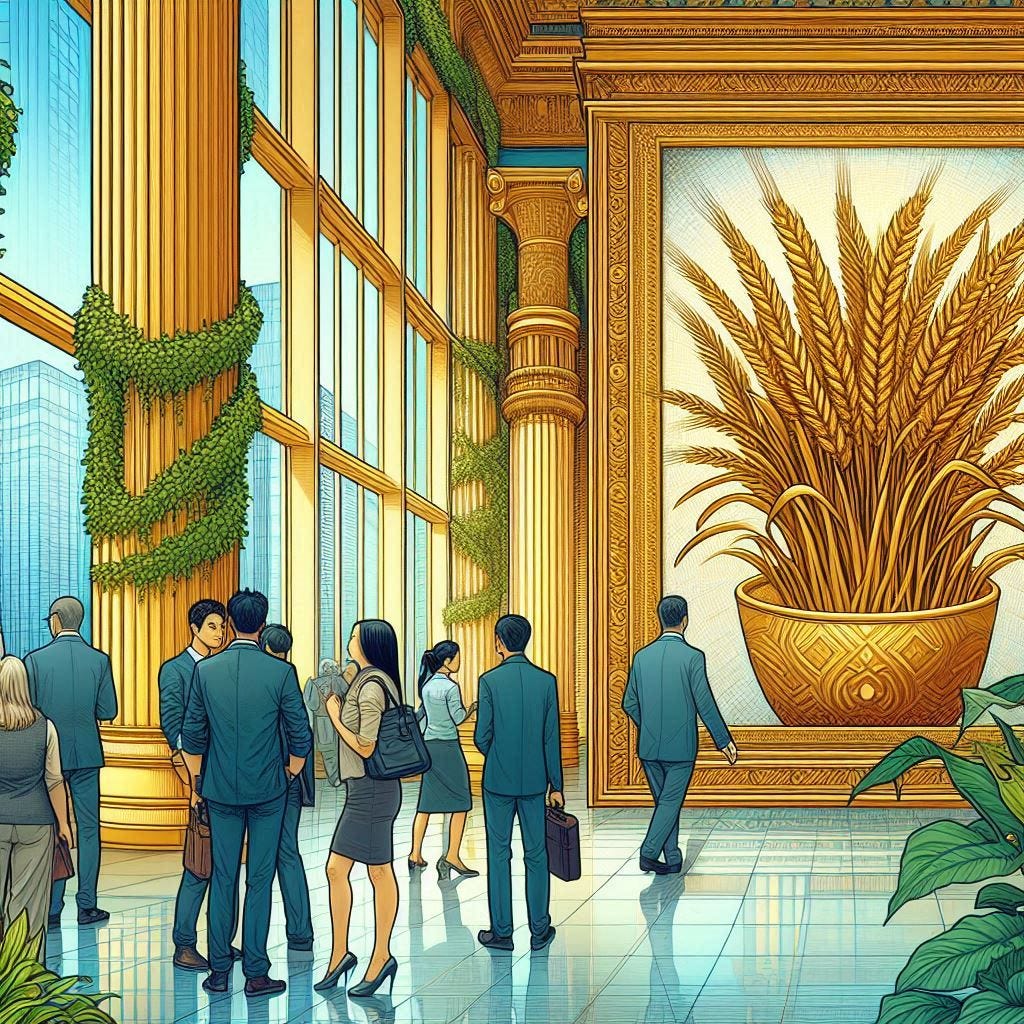A Golden Future
Isara greeted the guests in the museum’s foyer. Today’s group were a diverse set of dignitaries across southeast Asia. She waited until all of them had inserted their babelfishes before she began.
She stepped in-between the group. She felt all of their eyes on her. She was the expert, and they were all here to learn from her. Overhead was the gentle hum of the hydroponic system.
“Welcome honored guests, to the Manila Museum of Agriculture. Today I will lead you on a journey through the annals of human ingenuity and the evolution of food in our beloved Phillippines.”
Her audience followed her into a softly lit gallery. Along the wall were photographs and interactive displays chronicling the country’s struggles and triumphs in agriculture.
She stopped in front of a weathered photograph that showed emaciated children with distended bellies.
“Malnutrition was a pervasive specter which haunted our islands for decades. Vitamin A deficiency was just one problem that threatened our health and development. Of course, that was all before the advent of genetic engineering.”
She led them to a vibrant mural which depicted lush rice paddies that glistened like prized minerals.
“Through the hard work of our agriculture academics, funded by our taxes, they developed an new cultivar that was made publicly available. By splicing genes from successful crops around the world, they were able to imbue rice with the beta-carotene, a precursor to vitamin A.”
“Excuse me,” a woman called out with her hand up. “Wasn’t there controversy surrounding genetically modified organisms?”
The guide gave her a gracious smile.
“Yes there was,” she answered. “There is still some hesitancy. However, our transparent process and decades of field trials have consistently demonstrated the safety and effectiveness of our golden rice. It has quickly become a critical staple food for millions. We’ve managed to eradicate vitamin A deficiency and improve overall health outcomes.”
She led the group further down the hallway, where red lights flickered overhead.
“The Philippines as you have seen is a large collection of tropical islands. As climate change grew worse, it had a severe impact on us first. It’s hard for plants to grow in weather approaching 40 degrees, and it’s hard for anyone to be outside to harvest. It’s even harder when typhoon season rocks farmland almost constantly for months.
“That’s why we had to learn agriculture from others. We took their learnings and incorporated them into our crops. They’re weather resistant, able to grow even better in the supertropical weather.”
She led them into the heart of the museum, where a series of hydroponic towers glistened.
“As our population continues to grow, and our arable land becomes increasingly scarce, our future is here.”
In front of them was a hologram which came to life.
“Imagine a world where every rooftop, every balcony, every abandoned building is transformed into thriving vertical farms. Imagine where food is abundant, a catalyst for community rather than a source of conflict.”
The tour continued, taking them to a projection of the Philippines projected onto the floor. Digital boats moved dynamically between the islands. After a minute, planes and drones appeared and traveled across the sky.
She paused, allowing the guests to take in this display of civilization.
“The true power of innovation is not in the technology alone, but in our willingness to embrace change and challenge old traditions. With healthy children, we’re able to grow as a people and cultivate a future that is both sustainable and equitable.
“Come now, we’re nearly at the end of our tour.”
Isara led the tour through the projection, through the National Hall of Fame, to a grand escalator. They stepped on and were lifted upwards to the rooftop terrace.
She stepped towards the edge and looked out at the sprawling metropolis. In her view were a dozen or so cranes hard at work, continuing to build towards a better future. She took in a deep breath of air, smelling the roses that grew along the wall.
“From this vantage point we can see the fruits of our collective labor, a momument to the resilience and ingenuity of the Filipino people. We have continued to develop our drive for innovation and a world of shared joy and health for all.”
This is a story in a timeline where golden rice becomes an abundant crop in the Philippines and brings a number of health benefits. It could be a significant leap in well-being. Unfortunately, in our currently timeline this crop won’t be allowed to grow due to a lawsuit. This story is meant to help illustrate a better future.


